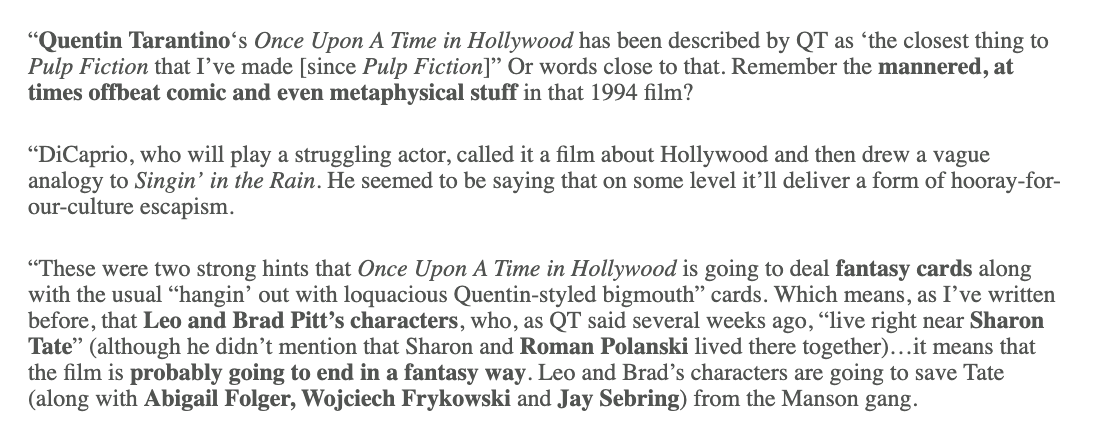In a 7.25 piece called “Tarantino Spoiler Policy”, I wrote that “I don’t know when it will be fair to start discussing the final 20 to 25 minutes” of Once Upon A Time in Hollywood “but I would think that an ‘olly olly in come free’ policy could be instituted as of…what, Monday morning? Is it realistic to expect that people will keep their yaps shut any longer than that?”
Actually the cat scampered out of the bag earlier today with Owen Gleiberman‘s 7.28 Variety think piece **, titled “Once Upon a Time in Hollywood: Let’s Talk About That Ending“.
Owen basically says two things — that he doesn’t care for the ending at all, but that he also realizes that Quentin Tarantino had pretty much painted himself into an impossible corner when he decided to make this Hollywood-in-the-late-’60s, Manson-shaded film, and therefore understands why he did what he did. Because everyone would have been sickened by a recreation of what actually happened to Sharon Tate and her housemates on that horrible night, and that an alternative fantasy was necessary to make the film palatable.
I began predicting this narrative approach in early ’18, and in fact said the following in a 4.24.18 piece titled “Tarantino’s Not-Manson Flick Will Deal Escapist Cards“:

I also believe that Richard Brody has half a point in his 7.27 New Yorker essay, “Quentin Tarantino’s Obscenely Regressive Vision of the Sixties in Once Upon a Time in Hollywood”.
“Tarantino’s love letter to a lost cinematic age is one that, seemingly without awareness, celebrates white-male stardom (and behind-the-scenes command) at the expense of everyone else,” he writes.
Tarantino is saying, in Brody’s view, that “if only the old-line Hollywood people of the fifties and sixties had maintained their pride of place — if only the times hadn’t changed, if only the keys to the kingdom hadn’t been handed over to the freethinkers and decadents of the sixties — then both Hollywood and the world would be a better, safer, happier place. [Because] there’s no slur delivered more bitterly by Cliff and Rick than ‘hippie’, and their narrow but intense experiences in the course of the film are set up to bear out the absolute aptness of their hostility.”
Remember Peter Fonda‘s line about the ’60s in Steven Soderbergh and Lem Dobbs‘ The Limey? That it was “’66 and early ’67…that’s all it was“? Which implied that hippie culture had become degraded if not poisoned by late ’69, which is pretty close to the truth.
Once Upon A Time in Hollywood strenuously avoids this kind of acknowledgment or summation. Not once does Tarantino even glance at what was actually happening back then in terms of the spiritual current and the social-political upheavals. He avoids “the ’60s” as strenuously as Mike Nichols and Buck Henry did when they made The Graduate.
I’m not suggesting there was anything the least bit angelic or utopian about Charles Manson, but his followers, at heart, minus the malevolent influence, probably weren’t much different than many of the tribal 20somethings who celebrated at the ’69 Woodstock festival. But Tarantino insists on depicting them as creepy aliens. When Brad Pitt‘s Cliff Booth visits the Spahn Ranch in Act Two, Tarantino directs the Manson family members to speak in a zombified manner and stand around in tableau like the blonde kids in Village of the Damned. They’re not people — they’re things.
Joe Leydon to HE: “Just wondering if we should assume Charles Manson sent some of his surviving followers to the hospital to kill Cliff Booth?”
** I’ve omitted the ellipses in the movie title as well as those in the title of Owen’s piece — in both instances they’re pretentious and irksome.
Watch this animated Jon Peters video between 2:20 and 3:00:
